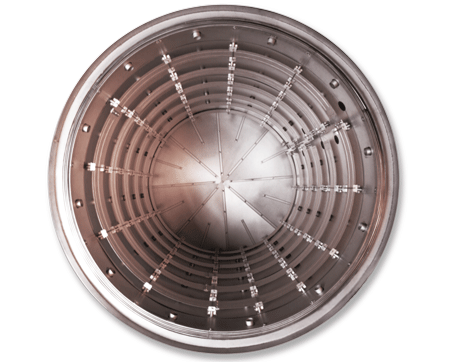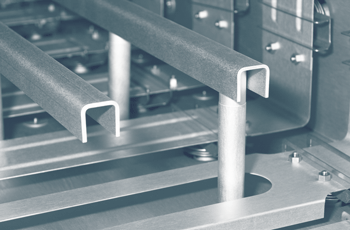Energy efficient metallic hot zones for vacuum furnaces
Hot zones form the heart of every vacuum furnace. Heating elements ensure the necessary temperature, charge carriers position the material in the furnace and the shield packs minimize the amount of heat that escapes from the furnace chamber.
In 80% of all vacuum furnaces, the insulation consists of solid graphite plates or graphite felt. Although this design saves energy, the employed material is a poor heat absorber and takes a long time to cool down. Furthermore, the presence of carbon in the furnace is problematic when sensitive processes and materials are involved.
In a metallic hot zone, the shielding consists of molybdenum, tungsten or stainless steel. Despite the higher cost of procurement, fully metallic hot zones are gaining in popularity among furnace-makers and operators. The following properties argue in favour of the use of fully metallic hot zones:
- long service lives
- rapid heating and cooling
- optimum process purity thanks to graphite-free materials
- short pumping times
- excellent vacuum conditions
- uniform heat distribution
While in the 1960s, such constructions still had a reputation for high energy consumption, modern designs of fully metallic hot zones are often real energy savers.
As an expert in the field of molybdenum and tungsten, Plansee has developed a particularly energy-efficient form of heating. ENERZONE® is a series of fully metallic hot zones that consume approximately a quarter less energy than conventional designs.
Cutting energy needs by a quarter
Molybdenum charge carriers are generally used in conventional metal hot zones for vacuum furnaces. In most cases, these consist of a number of heavy rails that are supported on the furnace floor by massive caps and bolts. In the ENERZONE®, Plansee now uses particularly lightweight bearing rails made from molybdenum alloys which are bent into a U-shape. These lie directly on the bolts and simply have to be cross-pinned, caps are no longer needed.
There is a welcome side effect to this in that the new charge carriers are less susceptible to distortion and are much easier to replace than their heavyweight counterparts.
To save even more weight, Plansee has replaced pure molybdenum with the molybdenum alloys ML and TZM. Thanks to their high recrystallization temperature and creep resistance, the more lightweight shielding panels and charge carriers made from ML and TZM are rigid and non-deformable.
Stainless steel elements have also been replaced with molybdenum, as a single layer of molybdenum has the same shielding effect as five layers of steel.
In conventional shielding solutions, the spacers between the panels are arranged longitudinally. To prevent the deforming of the material, this design requires the use of particularly thick shielding panels. They ensure that the hot zone is non-deformable and guarantee that the cylindrical geometry is maintained. Circumferential spacers have now been developed and when combined with an external stainless steel support frame, these spacers guarantee adequate stability even when thinner panels are used.
The ENERZONE® system is equipped with special corner shielding elements to ensure that no heat escapes at the critical gaps between the side and ceiling or side and floor. Additional shielding discs also make sure that no energy is lost at the electrical ducts.
Plansee can also supply its ENERZONE® hot zones in a completely new hybrid design. Conventional shielding panels are supplemented by an insulating aluminum oxide paper. The operation of the unit is not affected by the aluminum paper. Heating and cooling speeds, cycle times and purity constraints are all unimpaired. In contrast, energy consumption is cut by 10-15%.
Key advantages of ENERZONE®
ENERZONE® not only consumes less energy but also provides even better performance along the way. The improved hot zone heats up faster, cools down more quickly and therefore guarantees shorter cycle times than its heavyweight colleagues.
Using the example of a fully metallic hot zone measuring 600 mm x 600 mm x 900 mm, compared to a standard variant, an energy-efficient lightweight construction brings the following advantages:
- 15-20% weight reduction
- 20 % reduction in heating times in empty furnace
- 15 kW less heat loss
- 25-30 kWh reduction in energy consumption when heating and cooling the furnace
- 15 % reduction in cooling times
Plansee states that this all-rounder is not the cheapest hot zone on the market, however its long service life and energy efficiency make it a good long-term investment.
Contact [email protected]
News | Articles | Market reviews | Search directory | Subscribe to e-newsletter







